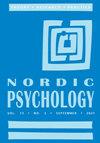Problems of diagnostic psychiatry—and the search for a way forward
IF 1.1
4区 心理学
Q4 PSYCHOLOGY, MULTIDISCIPLINARY
引用次数: 0
Abstract
AbstractThe recent history of psychiatry is one of diagnostic expansion. Since the etiological model of mental illness was superseded by the symptom model around 1980, new diagnoses have continuously been added to the reigning manuals of psychopathology, most recently with DSM-5 and ICD-11. This article unfolds some of the criticism that has recently been directed at diagnostic psychiatry with a focus on two quite different lines of critical thought: One represented by a neuroscientific approach known as RDoC, which argues that psychiatry must move beyond symptoms and find the causes of mental illness in the brain (Insel et al., Citation2010), and another represented by a contextual approach known as PTMF, which argues that mental distress is by and large understandable in light of what happens to people (Boyle & Johnstone, Citation2020). These oppositional perspectives stand out as prototypical, and each contain valuable insights but also limitations. The article ends by arguing that the limitations can be overcome if the perspectives are united by a hybrid theory stating that mental illness is always a property of a relation between a person and an environment. Two such theories are introduced and discussed (Gannik, Citation2002; Wakefield, Citation1992).Keywords: psychiatric diagnosesmental illnesspathologizationsymptomsneurosciencecontext Disclosure statementNo potential conflict of interest was reported by the author.Notes1 There are of course other alternative conceptualizations, which I cannot address in detail here, e.g., HiTOP (Kotov et al., Citation2017).2 The following sections rework material from Brinkmann (Citation2016b).Additional informationFundingDanmarks Frie Forskningsfond诊断精神病学的问题——以及对前进道路的探索
摘要精神病学的近代史是诊断扩展史。自从1980年前后精神疾病的病因模型被症状模型所取代以来,新的诊断不断被添加到主流精神病理学手册中,最近的是DSM-5和ICD-11。这篇文章揭示了最近针对诊断精神病学的一些批评,重点是两种截然不同的批评思想:一种以神经科学方法RDoC为代表,该方法认为精神病学必须超越症状,在大脑中找到精神疾病的原因(Insel等人,Citation2010),另一种以情境方法PTMF为代表,该方法认为,根据人们发生的事情,精神痛苦基本上是可以理解的(Boyle和Johnstone, Citation2020)。这些对立的观点都是典型的,每个观点都包含有价值的见解,但也有局限性。文章最后指出,如果这些观点被一种混合理论联合起来,即精神疾病总是一个人与环境之间关系的属性,那么这些局限性是可以克服的。本文介绍并讨论了两种这样的理论(Gannik, Citation2002;韦克菲尔德,Citation1992)。关键词:精神诊断精神疾病病理症状神经科学背景披露声明作者未报告潜在利益冲突。注1当然还有其他替代概念,我无法在这里详细说明,例如HiTOP (Kotov et al., Citation2017)以下几节是对布林克曼(Citation2016b)材料的返工。其他信息资助丹麦Frie Forskningsfond
本文章由计算机程序翻译,如有差异,请以英文原文为准。
求助全文
约1分钟内获得全文
求助全文

 求助内容:
求助内容: 应助结果提醒方式:
应助结果提醒方式:


